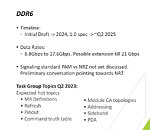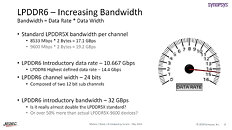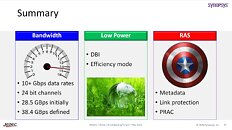- Joined
- Oct 9, 2007
- Messages
- 47,670 (7.43/day)
- Location
- Dublin, Ireland
| System Name | RBMK-1000 |
|---|---|
| Processor | AMD Ryzen 7 5700G |
| Motherboard | Gigabyte B550 AORUS Elite V2 |
| Cooling | DeepCool Gammax L240 V2 |
| Memory | 2x 16GB DDR4-3200 |
| Video Card(s) | Galax RTX 4070 Ti EX |
| Storage | Samsung 990 1TB |
| Display(s) | BenQ 1440p 60 Hz 27-inch |
| Case | Corsair Carbide 100R |
| Audio Device(s) | ASUS SupremeFX S1220A |
| Power Supply | Cooler Master MWE Gold 650W |
| Mouse | ASUS ROG Strix Impact |
| Keyboard | Gamdias Hermes E2 |
| Software | Windows 11 Pro |
The next-generation PC DDR6 memory standard (not to be confused with GDDR6), will offer a 10-times increase in bandwidth over DDR4, according to a presentation by Synopsys, a major vendor of memory controller and PHY IP blocks. The initial draft of DDR6 specification by JEDEC is expected to be ready within 2024, with version 1.0 of the spec ready by mid-2025. Speeds (data-rates) of DDR6 start at DDR6-8800, and range up to DDR6-17600 in the first generation; with future generations of DDR6 going all the way up to DDR6-21333 (or 21 Gbps). This is exactly 10 times the bandwidth of DDR4-2133, the initial speed of DDR4 that debuted with 6th Gen Core "Skylake" processors, almost a decade ago. It hence makes sense for a memory specification 10 years since to offer such a linear scaling in bandwidth.
Synopsys also talks about LPDDR6 in this presentation, the future low power memory standard for thin-and-light computing devices and smartphones. LPDDR6 will have an introductory data-rate of LPDDR6-10667 over a 24-bit memory channel, with two 12-bit sub-channels. The highest defined data-rate for LPDDR6 is expected to be LPDDR6-14400 (likely 14466 MT/s). Besides generational increases in bandwidth, both PC DDR6 and LPDDR6 are expected to introduce several security and energy-efficiency features, including an "efficiency mode" that reduces idle power draw for the memory devices.



View at TechPowerUp Main Site | Source
Synopsys also talks about LPDDR6 in this presentation, the future low power memory standard for thin-and-light computing devices and smartphones. LPDDR6 will have an introductory data-rate of LPDDR6-10667 over a 24-bit memory channel, with two 12-bit sub-channels. The highest defined data-rate for LPDDR6 is expected to be LPDDR6-14400 (likely 14466 MT/s). Besides generational increases in bandwidth, both PC DDR6 and LPDDR6 are expected to introduce several security and energy-efficiency features, including an "efficiency mode" that reduces idle power draw for the memory devices.



View at TechPowerUp Main Site | Source






